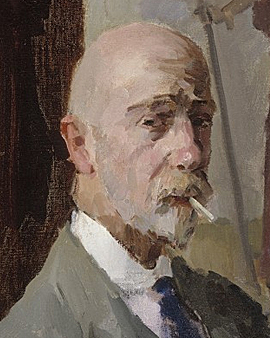Isaac Israëls was born in Amsterdam in the Netherlands and is considered an important representative of the "Amsterdam Impressionism" art movement, which had emerged from the "Hague School". Isaac's father was the painter Jozef Israëls, who in turn was an important representative of the aforementioned Hague School. Jozef Israëls recognized Isaac's artistic talent at an early age, and he promoted him accordingly. As a youth he studied at the Academy of Fine Arts in The Hague, where he met his lifelong close friend George Hendrik Breitner. Israëls' talent was not hidden from the world around him; as early as 1881 - at the age of 16 - he sold a painting that was not even finished to the collector Hendrik Willem Mesdag. As early as 1878, Israëls and his father had attended the annual exhibition of the Salon des Artistes Français in Paris; in 1882 he was able to exhibit his own work ("Military Burial") there for the first time.
In 1886 Israëls returned to Amsterdam and enrolled at the Reichsakademie für Bildende Künste together with Breitner to continue his education. However, they left the Academy after only one year. Instead, they joined the progressive circle of the "Tachtiger" ("Eighties"), a leading group of young authors and other artists. Inspired by the group, Israëls became a chronicler of the streets, cafes and entertainment venues of Amsterdam. In the summer, Israëls spent a lot of time in Scheveningen on the North Sea coast. Here he also met the German painter Max Liebermann and the Frenchman Édouard Manet, with whom he worked a lot.
At the end of the nineteenth century, Israëls discovered another field of interest: the fashion world, which he portrayed from the catwalk to the dressing room. Israëls experienced the beginning of the First World War by painting in London. He spent the time of the war in the Netherlands. During this time he mainly painted portraits, his models included not only women from the neighbourhood but also well-known personalities and even the still famous Mata Hari.
After the war, Israel travelled to India and Indonesia, where he created well-known street scenes and pictures of gamelan musicians. After his journey he settled in the house of his deceased parents in The Hague. At the Olympic Games of 1928, which took place in Amsterdam - at that time Olympia was not yet a purely sporting event - ,he won a gold medal for his portrait "Red Rider". Israëls died in The Hague after a traffic accident.
×





.jpg)
.jpg)
_-_(MeisterDrucke-892736).jpg)
_-_(MeisterDrucke-892736).jpg)
.jpg)
.jpg)
.jpg)
.jpg)
.jpg)
.jpg)
_-_(MeisterDrucke-891710).jpg)
_-_(MeisterDrucke-891710).jpg)
.jpg)
.jpg)
.jpg)
.jpg)
.jpg)
.jpg)
.jpg)
.jpg)
.jpg)
.jpg)
.jpg)
.jpg)
.jpg)
.jpg)
.jpg)
.jpg)
.jpg)
.jpg)
.jpg)
.jpg)
.jpg)
.jpg)
.jpg)
.jpg)
_-_(MeisterDrucke-892256).jpg)
_-_(MeisterDrucke-892256).jpg)
.jpg)
.jpg)
_-_(MeisterDrucke-1440661).jpg)
_-_(MeisterDrucke-1440661).jpg)
.jpg)
.jpg)
.jpg)
.jpg)
.jpg)
.jpg)
.jpg)
.jpg)
.jpg)
.jpg)
.jpg)
.jpg)
.jpg)
.jpg)
.jpg)
.jpg)
.jpg)
.jpg)
.jpg)
.jpg)
.jpg)
.jpg)
.jpg)
.jpg)
.jpg)
.jpg)
.jpg)
.jpg)
.jpg)
.jpg)
_-_(MeisterDrucke-907112).jpg)
_-_(MeisterDrucke-907112).jpg)
.jpg)
.jpg)
.jpg)
.jpg)
.jpg)
.jpg)
.jpg)
.jpg)
.jpg)
.jpg)
.jpg)
.jpg)
.jpg)
.jpg)
.jpg)
.jpg)
.jpg)
.jpg)
.jpg)
.jpg)
.jpg)
.jpg)
.jpg)
.jpg)
.jpg)
.jpg)
.jpg)
.jpg)
.jpg)
.jpg)
.jpg)
.jpg)
.jpg)
.jpg)
.jpg)
.jpg)
.jpg)
.jpg)
.jpg)
.jpg)
.jpg)
.jpg)
_-_(MeisterDrucke-906911).jpg)
_-_(MeisterDrucke-906911).jpg)
.jpg)
.jpg)
.jpg)
.jpg)
.jpg)
.jpg)
.jpg)
.jpg)
.jpg)
.jpg)
.jpg)
.jpg)
.jpg)
.jpg)
.jpg)
.jpg)
.jpg)
.jpg)
.jpg)
.jpg)
.jpg)
.jpg)
.jpg)
.jpg)
.jpg)
.jpg)
.jpg)
.jpg)
.jpg)
.jpg)
.jpg)
.jpg)
.jpg)
.jpg)
.jpg)
.jpg)
.jpg)
.jpg)
.jpg)
.jpg)
.jpg)
.jpg)
.jpg)
.jpg)
.jpg)
.jpg)
.jpg)
.jpg)
.jpg)
.jpg)
.jpg)
.jpg)
.jpg)
.jpg)
.jpg)
.jpg)
.jpg)
.jpg)
.jpg)
.jpg)
.jpg)
.jpg)
.jpg)
.jpg)
.jpg)
.jpg)
.jpg)
.jpg)
.jpg)
.jpg)
_-_(MeisterDrucke-907958).jpg)
_-_(MeisterDrucke-907958).jpg)
.jpg)
.jpg)
.jpg)
.jpg)
.jpg)
.jpg)
.jpg)
.jpg)
.jpg)
.jpg)




